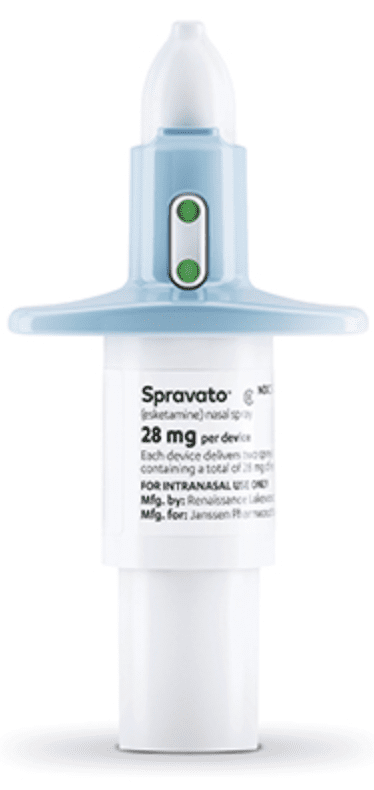Spravato Disease Interactions
There are 4 disease interactions with Spravato (esketamine).
Esketamine (applies to Spravato) high blood pressure
Major Potential Hazard, Moderate plausibility. Applicable conditions: Hypertension, Aortic Aneurysm, Allergies, History - Cerebrovascular Disease, Cerebral Vascular Disorder
Esketamine causes an increase in systolic and/or diastolic blood pressure at all recommended doses. The increase peaks approximately 40 minutes after administration of esketamine, and lasts for about 4 hours. Blood pressure should be monitored prior and after administration. If baseline blood pressure is elevated before administering (e.g., >140 mmHg systolic, >90 mmHg diastolic), consider the risks of short term increases in blood pressure and benefit of treatment in patients with treatment- resistant depression (TRD). Do not administer esketamine if an increase in blood pressure or intracranial pressure poses a serious risk. Esketamine is contraindicated in patients with aneurysmal vascular disease (including thoracic and abdominal aorta, intracranial, and peripheral arterial vessels), arteriovenous malformations, or a history of intracerebral hemorrhage.
Esketamine (applies to Spravato) psychosis
Major Potential Hazard, Moderate plausibility.
Esketamine can cause dissociative or perceptual changes (including distortion of time, space and illusions), derealization and depersonalization. Patients with psychosis must be carefully assessed before administering esketamine, and treatment should be initiated only if the benefit outweighs the risk. Patients must be monitored by a healthcare provider for at least 2 hours at each treatment session, followed by an assessment to determine when the patient is considered clinically stable and ready to leave the healthcare setting.
Esketamine (applies to Spravato) substance abuse
Major Potential Hazard, Moderate plausibility. Applicable conditions: Drug Abuse/Dependence
Esketamine, is a Schedule III controlled substance (CIII), and may be subject to abuse and diversion. Assess each patient's risk for abuse or misuse prior to prescribing esketamine and monitor all patients receiving treatment for the development of these behaviors or conditions, including drug- seeking behavior, while on therapy. Individuals with a history of drug abuse or dependence are at greater risk; therefore, use careful consideration prior to treatment of individuals with a history of substance use disorder and monitor for signs of abuse or dependence.
Esketamine (applies to Spravato) hepatic impairment
Moderate Potential Hazard, Moderate plausibility. Applicable conditions: Liver Disease
Esketamine has not been studied in patients with severe hepatic impairment (Child-Pugh class C). Use in this population is not recommended. Additionally, the mean esketamine AUC and t1/2 values were higher in patients with moderate hepatic impairment compared to those with normal hepatic function. Patients with moderate hepatic impairment may need to be monitored for adverse reactions for a longer period of time.
Switch to professional interaction data
Spravato drug interactions
There are 296 drug interactions with Spravato (esketamine).
Spravato alcohol/food interactions
There are 2 alcohol/food interactions with Spravato (esketamine).
More about Spravato (esketamine)
- Spravato consumer information
- Check interactions
- Compare alternatives
- Pricing & coupons
- Reviews (127)
- Drug images
- Side effects
- Dosage information
- During pregnancy
- FDA approval history
- Drug class: miscellaneous antidepressants
- Breastfeeding
- En español
Related treatment guides
Drug Interaction Classification
| Highly clinically significant. Avoid combinations; the risk of the interaction outweighs the benefit. | |
| Moderately clinically significant. Usually avoid combinations; use it only under special circumstances. | |
| Minimally clinically significant. Minimize risk; assess risk and consider an alternative drug, take steps to circumvent the interaction risk and/or institute a monitoring plan. | |
| No interaction information available. |
See also:
Further information
Always consult your healthcare provider to ensure the information displayed on this page applies to your personal circumstances.


